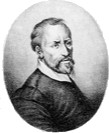Giovanni Pierluigi da Palestrina (1525-1594)
Requiem (1551)
 Giovanni Pierluigi da Palestrina (1525-1594) wrote no less than 104 masses and just one requiem, which he based on Gregorian chant, as was conventional at the time.
Giovanni Pierluigi da Palestrina (1525-1594) wrote no less than 104 masses and just one requiem, which he based on Gregorian chant, as was conventional at the time.
His work was considered at the time as exemplary: this is the way music had to be in Roman Catholic worship. The text was intelligible, the music contained no illicit references to secular songs or other dissonances that would only draw the attention away from the message and give the ear 'hollow enjoyment'.
Tu es Petrus
‘The function of church music is not to delight the ears but to strengthen the impact of the words of the liturgy and to incline the hearts of the listeners towards a longing for heavenly harmony and the contemplation of the joys of the blessed. (…) They shall also banish from the churches all such music which, whether by the organ or in the singing, contains things that are lascivious or impure’
This text from the Council of Trent Decree (1545-1563) had significant consequences for sixteenth century church music. The text was not clear about what was ‘lascivious’ or ‘impure’, and left it to the bishops of the various dioceses to decide. The question is whether Gesualdo’s sacred music would meet these requirements.
In any case the works Palestrina - singer, composer and choir conductor - answered the council’s needs: he worked his whole life in Rome and ultimately obtained the title ‘prince of music’.